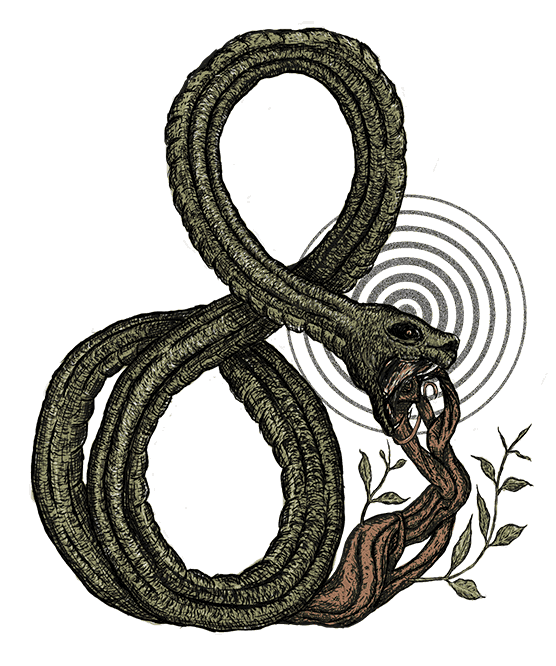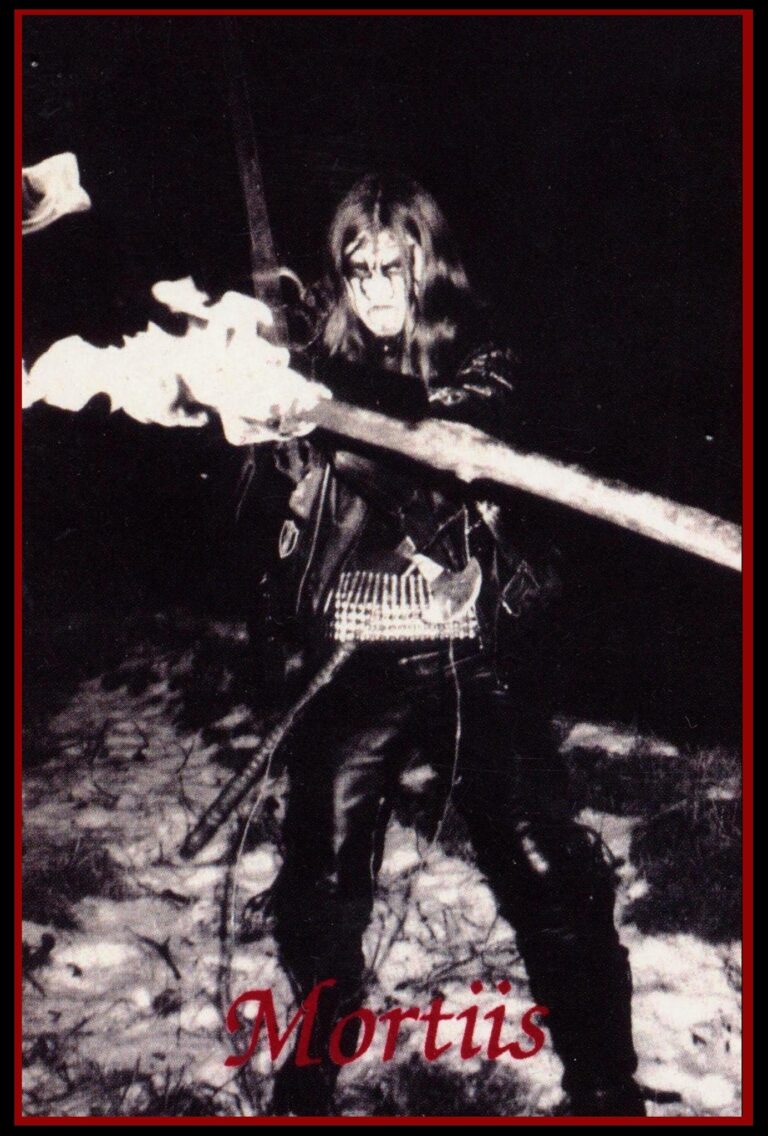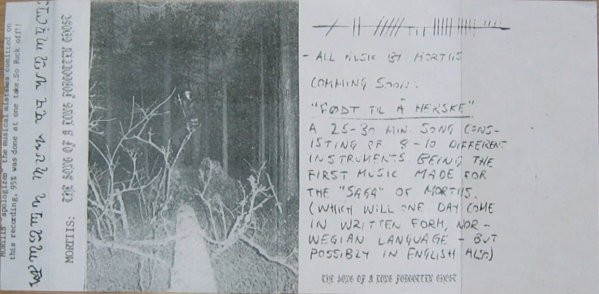Mortiis|Vond I
2024-01-24
by Niklas Göransson
Amidst the complete upheaval of Norwegian black metal in 1993 , Mortiis left Emperor and set out on a solitary journey. The genre-defining demo that followed marked the beginning of a new era, paving the way for his debut album, Født til å herske.

MORTIIS: As a teenager, I was the typical Norwegian black metal guy, which basically meant hating fucking everyone for no good reason. Feeling like an outsider – a misfit – was the norm. And indeed, you were one. These days, black metal aesthetics are commonplace, but back then you’d get beaten up for wearing bullet belts, spikes, and inverted crosses. It almost fostered a gang mentality, so you wanted to involve yourself as deeply as possible.
And that he did. In 1990, at fifteen years of age, Mortiis released the first issue of his fanzine, Zombie Anal Sex Terror, featuring bands like BLASPHEMY, SARCÓFAGO, and VITAL REMAINS. At the time, he also ran a small distro called Posercorpse Distribution and played with a death metal band called RUPTURENCE.
MORTIIS: There weren’t many of us, so dedication came naturally. It evolved into something very personal – almost like a part of your DNA. I actually stopped drinking when I got into black metal; I had this idea that there should be some discipline. Watching drunk people and seeing how foolish they looked, I thought, ‘I’m not gonna be one of those idiots.’ So, I didn’t drink for a few years.
In early 1991, after only six months of activity, RUPTURENCE split up. Mortiis then joined a short-lived doom band called WILT OF BELIAL. Around the same time, he founded Mysticum Records with Samoth – a friend who played in local death metal act THOU SHALT SUFFER.
MORTIIS: Mysticum Records was essentially a bootleg label. We were into tape trading and had gotten hold of all these cool CELTIC FROST rehearsal tapes; Samoth and I decided to compile this material and release it as a limited EP. Everything was ready, and it was gonna look fucking great. We even had the cover art in place, similar to those cut-and-paste pages you’d make for underground magazines. That EP would’ve been quite valuable today had it actually materialised.
Why didn’t it?
MORTIIS: It felt a bit risky. What if Tom G Warrior found out? Thinking back now, I doubt he would’ve minded – the real issue was Noise Records or whoever held the publishing rights to the songs. They’d probably have come down hard on us. We eventually decided that it was too big of a gamble. Moreover, the financial aspect played a role; pressing records costs money, and when you’re only sixteen, you simply don’t have the funds. So yeah, that was the rise and fall of Mysticum Records.
Later in ‘91, Samoth and his friend Ihsahn – who also played with THOU SHALT SUFFER – formed a black metal project. Mortiis was recruited on bass and ended up suggesting a name: EMPEROR. His involvement both with this band and Norwegian black metal was chronicled extensively in our Bardo Methodology #7 conversation.
Simultaneously, Mortiis kept working on his fanzine. Zombie Anal Sex Terror #2 was released in 1992 and featured the likes of ABRUPTUM, BEHERIT, NECROMANTIA, SADISTIK EXEKUTION, NOCTURNUS, and CARCASS. Both issues are available in Cult Never Dies’ Z.A.S.T. Zine Anthology 1990-1992.
In Orcustus #2 from the same year, the editor – Faust, a pen-pal of Mortiis – stated that Z.A.S.T. was being renamed Memorium for the upcoming third edition.
MORTIIS: I never managed to finish it, which pisses me off because I put in a lot of work. My writing had improved – I did a really long interview with POSSESSED, who were reforming for the first time – and I was making significant progress with the layout. I don’t know how you put your magazine together but back in those days, it was paper, glue, and an electric typewriter. Analogue cut and paste, basically. For Memorium, Ivar from ENSLAVED was helping me type out everything on a computer, which made it look much better.
Founded in 1991 by Ivar Bjørnson and Grutle Kjellson, ENSLAVED emerged from Haugesund on Norway’s west coast – a three-hour drive south of Bergen, the birthplace of bands such as BURZUM, IMMORTAL, and GORGOROTH. Mortiis, on the other hand, grew up in Notodden on the country’s east side, near Oslo. Born in 1977, Ivar was a few years younger than most of his black metal contemporaries.
MORTIIS: Ivar was a real musical prodigy; even at fourteen, he could play the fucking pants off most people. Jon Nödtveidt (DISSECTION) was obviously mega-talented – and the same with Euronymous, as well as Ihsahn. Those four were definitely the top dogs as far as musicians go. Anyway, Memorium #1 would’ve been a cool issue. I can’t remember why I didn’t put it out. Maybe because that was around the time EMPEROR took off.
That Orcustus issue is quite the time capsule. It’s from early ’92, yet Faust is already lamenting the overabundance of black metal bands and ‘zines. ‘The underground is dead’, proclaims BURZUM’s Varg Vikernes. Bear in mind now that this was before EMPEROR recorded their July 1992 demo, “Wrath of the Tyrant”, and DARKTHRONE released “A Blaze in the Northern Sky”.
There is actually a DARKTHRONE interview in Orcustus #2. It begins with Nocturno Culto disavowing their debut – the more death metal-oriented “Soulside Journey” – and threatening to stab anyone who brings it up to his face.
MORTIIS: <laughs> I must admit, we were probably a bit too consumed by that elitist black metal spirit. That’s an attitude I’m truly glad to have left behind. It blinds you, making you prejudiced and judgemental towards everything else. Just this notion of, ‘Fuck you for making different music’ – how absurd does that sound when stated out loud today? It’s ridiculous. Back then, we lacked respect for anything that wasn’t sufficiently black metal or didn’t have a cool Klaus Schulze atmosphere.
Klaus Schulze was a pioneering German composer of electronic music. Before launching his solo career in the early 70s, he was part of projects like TANGERINE DREAM and ASH RA TEMPEL.
MORTIIS: Besides black metal, I listened to a lot of what they call krautrock. I know that many of the German musicians who created that scene dislike the term, so I try to avoid using it out of respect. This love for TANGERINE DREAM was something I shared with Euronymous. One of the band’s early members, Conrad Schnitzler, even contributed to MAYHEM’s “Deathcrush”.
Did Euronymous ever tell you how that happened?
MORTIIS: I believe so, but I can’t recall the story in full detail now. The version I’m familiar with is that around ’86, the MAYHEM guys were backpacking across Europe, hanging out with cool German bands like ASSASSIN and KREATOR. It’s not clear to me whether Euronymous just showed up at Conrad’s place unannounced or had made an appointment – but they did meet.
As the story goes, Euronymous found the home address of Conrad Schnitzler, went to his house, and sat outside until he was eventually invited in.
MORTIIS: Fucking hell, that’s the type of person I would’ve hated. See, I once had a crazy German stalker. My apartment door had one of those letter slits that could be opened from the outside. So, she started off by talking into it and then began singing old German songs until I opened the door. Yeah, she was a fucking psycho, man. And to think Euronymous did the same thing… <laughs> That’s awesome.
When solicited for an intro, Schnitzler gave Euronymous an unreleased piece from his archives. This eventually became known as “Silvester Anfang” on MAYHEM’s 1987 EP “Deathcrush”.
MORTIIS: Conrad was this really cool, strange, and quirky musician. He never became as commercially successful as his bandmate Edgar Froese, who went on to achieve worldwide fame. But Conrad produced a lot of amazing material, distinctly weird and artistic. Just look at this MAYHEM intro he crafted back in the 80s; it would be challenging to replicate that even today. Considering the technology back then – almost forty years ago – it must’ve been fucking hard to produce that unique, increasingly pitchy percussive track.
Did you sense a connection between the likes of TANGERINE DREAM and black metal?
MORTIIS: Absolutely. TANGERINE DREAM varied in style over the decades, but their early work had this ethereal quality. To me, black metal has always been more about atmosphere than aggression, speed, or heaviness. Other genres can have those elements, but the essence of black metal lies in the ambience created and the vibes conveyed. This is my personal view, though others might see it differently. There was a connection between that feeling and the eerie synthesiser sounds these musicians produced, which immediately appealed to me. They even inspired me to pick up a keyboard and start creating my own music.
The “Wrath of the Tyrant” demo landed EMPEROR a record deal with Candlelight Records, following which Orcustus editor Faust joined the band as drummer.
In December 1992, EMPEROR entered Oslo’s Studio S to record seven songs. Four of them were used for a self-titled mini-LP as well as a split CD with ENSLAVED, whereas the rest ended up on the 1994 “As the Shadows Rise” EP. After the recording, Mortiis was asked to leave EMPEROR on account of his short fuse and lively temper.
MORTIIS: After getting booted from EMPEROR, I immediately began working on my own project. I was fed up with bands because, once again, I’d just had my point proven: that they always fucking fail. At least when I’m in them. But my love of music was really strong, so I knew I wanted to keep playing. Just not with other people.
In the spring of ’93, Mortiis recorded a demo called “The Song of a Long Forgotten Ghost”. This primitive yet groundbreaking tape became the blueprint for the first era of Mortiis’ solo project.
MORTIIS: When I developed my own concepts back in those days, they were often very naïve – yet I still wanted them to happen. My brilliant plan was to record the demo in a Transylvanian castle. I mean, that’s pretty much as unrealistic as you can get. There are a lot of logistics involved; like, how do you even get electricity into a 13th-century castle? Sure, you could probably rent diesel generators and shit, but, as a seventeen-year-old, I didn’t have a fucking clue. So, ultimately, I settled for recording it in my bedroom instead.
The tape that gave rise to dungeon synth was immortalised using the same analogue four-tracker as another genre-defining demo: “Wrath of the Tyrant”.
MORTIIS: I remember Ihsahn sitting there on my bed, pretty much just pushing play and record. While I was busy recording, he passed the time reading Conan magazines – most likely bored out of his fucking mind. He punched me in and out a few times when I made a playing mistake, and that was a kind of technique I didn’t know how to do. I had no freaking clue about anything, so I thought it would be better if Ihsahn handled this, seeing as how it was his machine.
The demo was released in June ’93 – how did you spread the word?
MORTIIS: Flyers, man. That was the only way back then. Someone who had a computer printed out some text for me. I organised a photo shoot in the woods on a small mountain behind my childhood home. My friend and I hiked up there and took a bunch of photos, but almost none were usable; it was too damn dark. Two or three turned out okay, so I picked one and slapped it on the flyer. I still had my shitty black metal attitude, so I added some text: ‘No free copies, fuck you!’ <laughs>
Back in the 1990s, freeloaders were a persistent annoyance – especially fans from places like Eastern Europe and South America.
MORTIIS: I mean, they’d even ask for promotional t-shirts! So, you knew it was just a scam: people looking for freebies. This happened a lot with EMPEROR. We used the same tactics with flyers and all that for “Wrath of the Tyrant”, and everyone wanted promo copies for their fucking fanzines. So, I decided I wasn’t gonna deal with any of it. I had people send me blank cassettes and international reply coupons – remember those? – and I’d dub the demo for them. Every single original demo was taped and dispatched by me personally.
Did you get a lot of interviews?
MORTIIS: Oh yes, tonnes of them. And I responded to every single one. Back in those days, the underground was all about this process. If you had a computer, you could type everything out, print the answers, and then send ‘em off with the stamp, flyers, and all that stuff. I did so much of this that it became a routine part of my day. More importantly, I believe it shaped a part of my promotional personality that still resonates today.
I can imagine that it must’ve been a nervous wait to see how the tape would be received in the unforgiving and narrow-minded underground metal scene.
MORTIIS: Yeah, I’d braced myself for all kinds of ridicule. To be honest, it was a bit unexpected that people liked it as much as they did because there really wasn’t anyone else in the metal scene doing this… well, except for Glenn Danzig with “Black Aria”. Sure, there were some complaints – you can’t escape them when doing something that weird – but the response was surprisingly positive. I guess a small sub-scene sprang up right there.
log in to keep reading
The second half of this article is reserved for subscribers of the Bardo Methodology online archive. To keep reading, sign up or log in below.


















